Comparing Two 1TB NVMe Drives with Same NAND, Same Controller: XPG SX8200 Pro vs HP EX950
by Billy Tallis on February 6, 2019 11:30 AM ESTRandom Read Performance
Our first test of random read performance uses very short bursts of operations issued one at a time with no queuing. The drives are given enough idle time between bursts to yield an overall duty cycle of 20%, so thermal throttling is impossible. Each burst consists of a total of 32MB of 4kB random reads, from a 16GB span of the disk. The total data read is 1GB.

The combination of Silicon Motion NVMe controllers and IMFT 64L 3D NAND continues to provide the best QD1 random read performance available from mainstream SSDs. The retail SM2262EN drives are slightly faster than the engineering sample we tested last year, which itself was an improvement. The top spot among the flash-based SSDs we have tested now belongs to the ADATA SX8200 Pro. The 1TB HP EX950 is slightly faster than the 2TB model.
Our sustained random read performance is similar to the random read test from our 2015 test suite: queue depths from 1 to 32 are tested, and the average performance and power efficiency across QD1, QD2 and QD4 are reported as the primary scores. Each queue depth is tested for one minute or 32GB of data transferred, whichever is shorter. After each queue depth is tested, the drive is given up to one minute to cool off so that the higher queue depths are unlikely to be affected by accumulated heat build-up. The individual read operations are again 4kB, and cover a 64GB span of the drive.

On the longer random read test that brings in some higher queue depths, the SM2262EN drives have a clear and substantial lead over the rest of the flash-based SSDs, including the SM2262-based EX920 and SX8200.
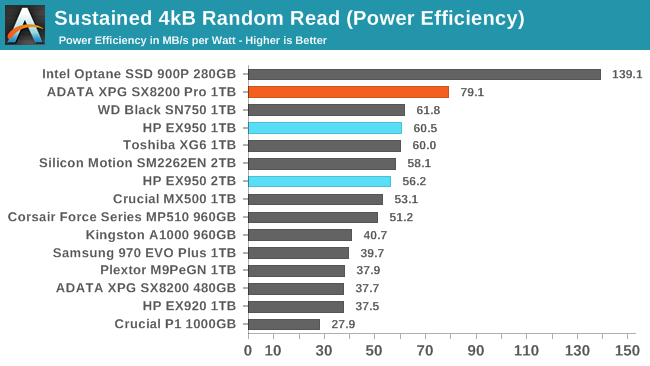 |
|||||||||
| Power Efficiency in MB/s/W | Average Power in W | ||||||||
The ADATA SX8200 Pro takes a clear lead in the efficiency rankings for the random read test, while the EX950 is tied with the WD Black SN750 and Toshiba XG6. The SX8200 Pro averages about 0.6 W lower power draw during this test than the EX950, which is the most power-hungry flash SSD in this bunch.
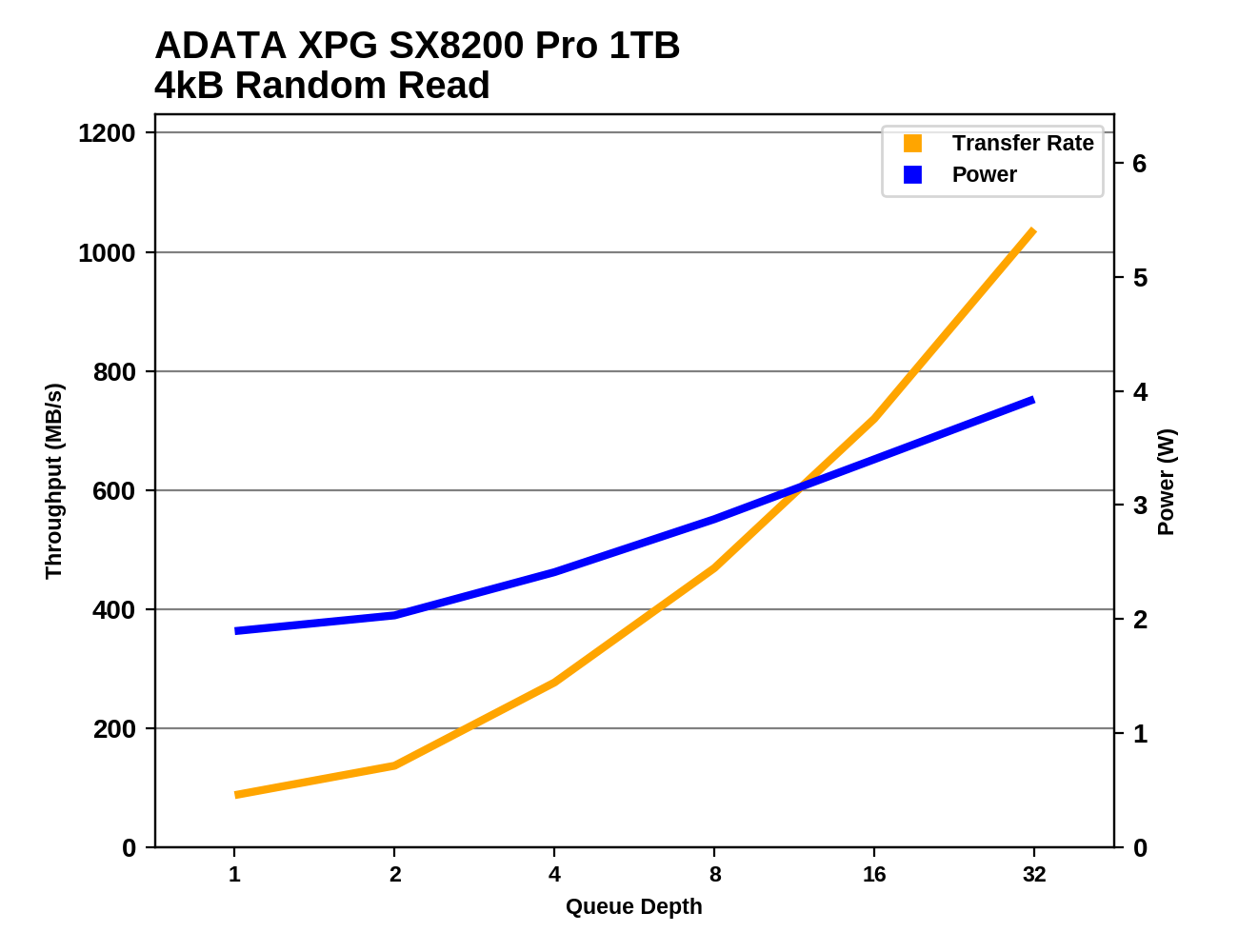 |
|||||||||
The 1TB SX8200 Pro and EX950 perform identically at each queue depth, but the SX8200 Pro has a persistent power draw advantage. The 2TB EX950 draws slightly more power and delivers slightly less performance across the entire tested range of queue depths. Compared to the rest of their competition, the SM2262EN drives maintain a lead in random read performance at every queue depth, and are very close to catching up with the Optane SSD by QD32.
The ADATA SX8200 Pro may be quite efficient for low queue depth random reads compared to other NVMe SSDs, but when graphed against our entire database of results, it is clear that plenty of SATA SSDs deliver better performance per Watt at low speeds, and at higher speeds and queue depths there are some NVMe SSDs that offer similar performance with lower power consumption.
Random Write Performance
Our test of random write burst performance is structured similarly to the random read burst test, but each burst is only 4MB and the total test length is 128MB. The 4kB random write operations are distributed over a 16GB span of the drive, and the operations are issued one at a time with no queuing.
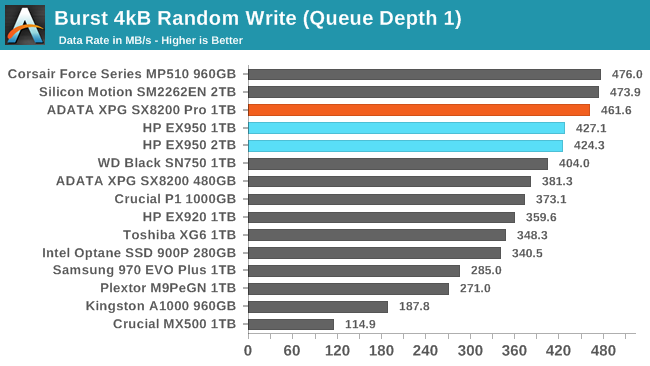
The burst random write performance of the retail SM2262EN drives is a bit lower than we got from the engineering sample we tested last year. The Phison E12-based Corsair Force MP510 is a few percent faster than the ADATA SX8200 Pro, and the HP EX950 is a bit slower but still faster than most other brands.
As with the sustained random read test, our sustained 4kB random write test runs for up to one minute or 32GB per queue depth, covering a 64GB span of the drive and giving the drive up to 1 minute of idle time between queue depths to allow for write caches to be flushed and for the drive to cool down.
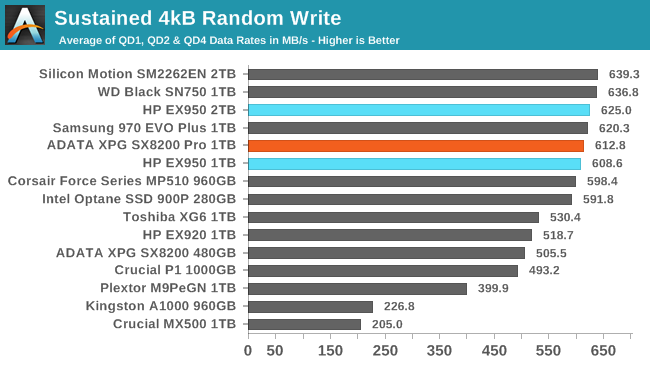
On the longer random write test that includes some higher queue depths, the SM2262EN drives stay near the top of the chart as the Corsair MP510 falls slightly behind and the WD Black SN750 and Samsung 970 EVO Plus catch up—but the overall spread among this top tier of drives is quite small. The 2TB HP EX950 is faster than the 1TB model but doesn't match the performance we got from the 2TB engineering sample.
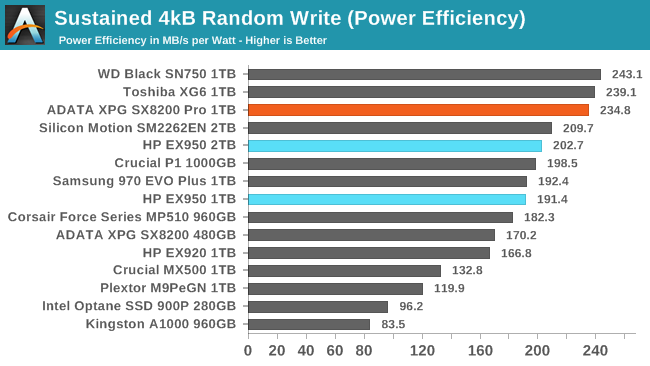 |
|||||||||
| Power Efficiency in MB/s/W | Average Power in W | ||||||||
The power efficiency of the ADATA SX8200 Pro on the random write test is very close to the Toshiba XG6 and WD Black SN750, and those three drives are clearly more efficient than the rest of this bunch, including the HP EX950.
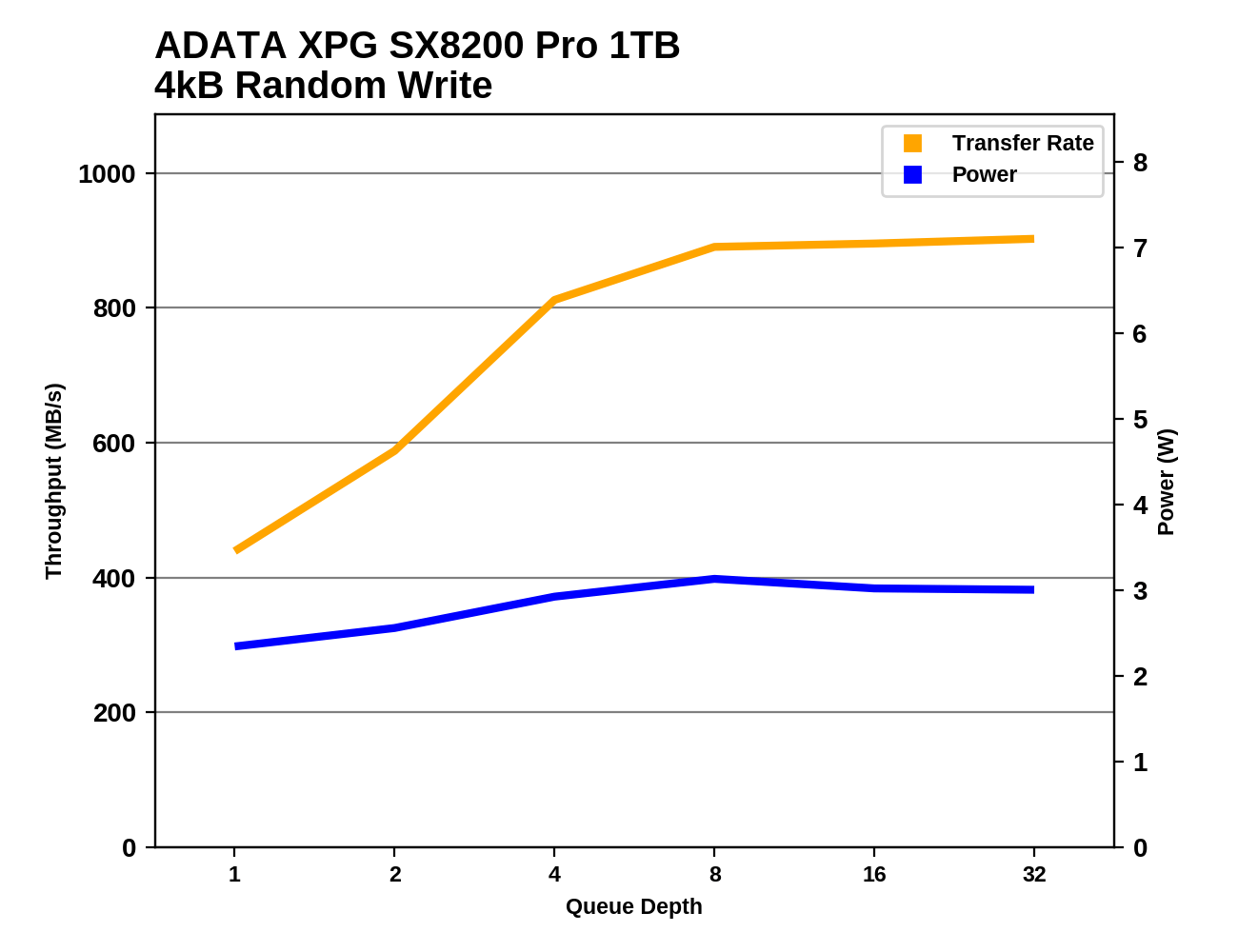 |
|||||||||
The WD Black SN750 and Samsung 970 EVO both start out a bit slower than the SM2262EN drives at QD1, but they reach full performance at QD4 while the SMI drives take a bit longer to saturate and aren't quite as fast at high queue depths.
The ADATA SX8200 Pro may not be able to quite match the fastest TLC drives for random write throughput, but across the entire range of tested queue depths it provides excellent power efficiency that few drives can match.


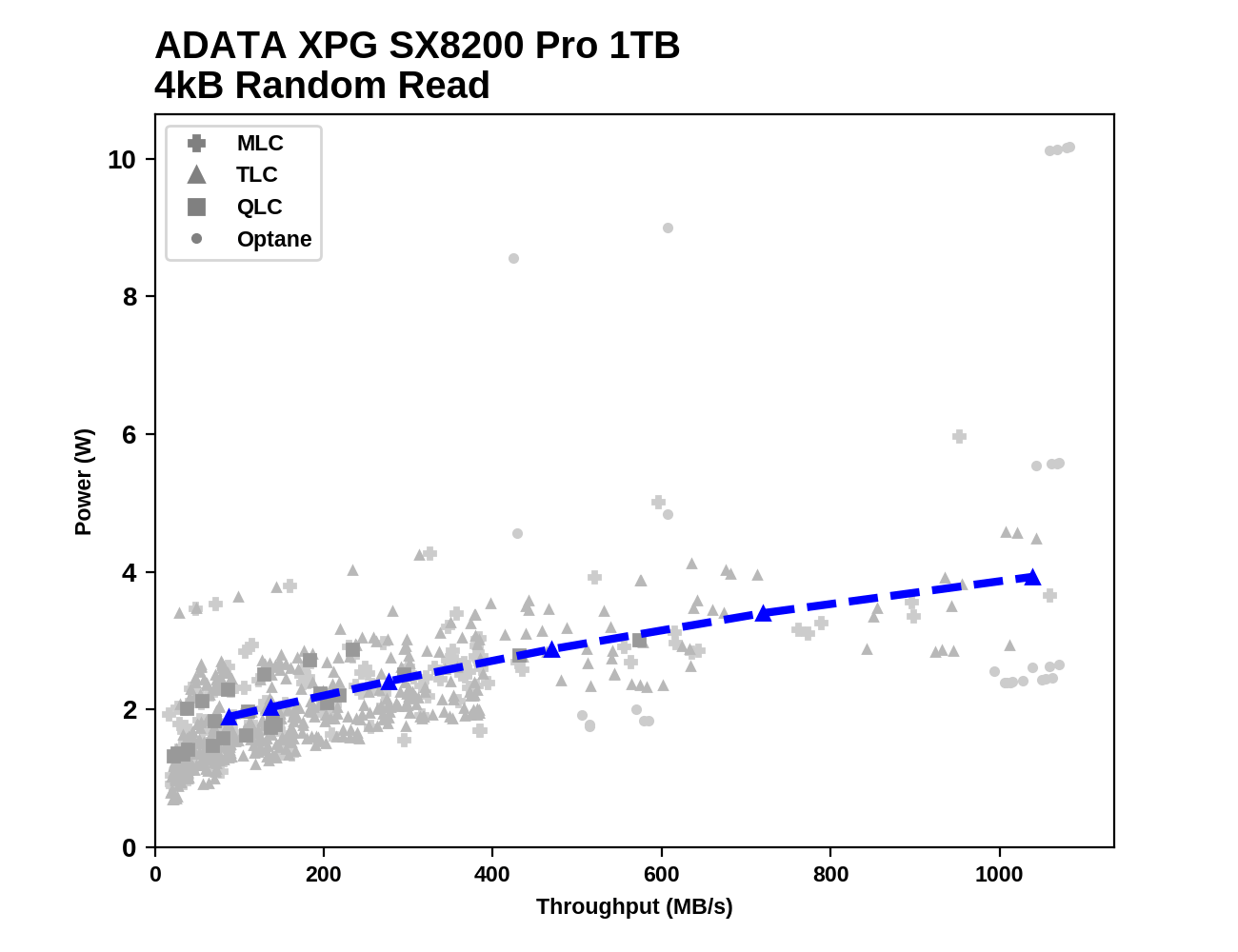
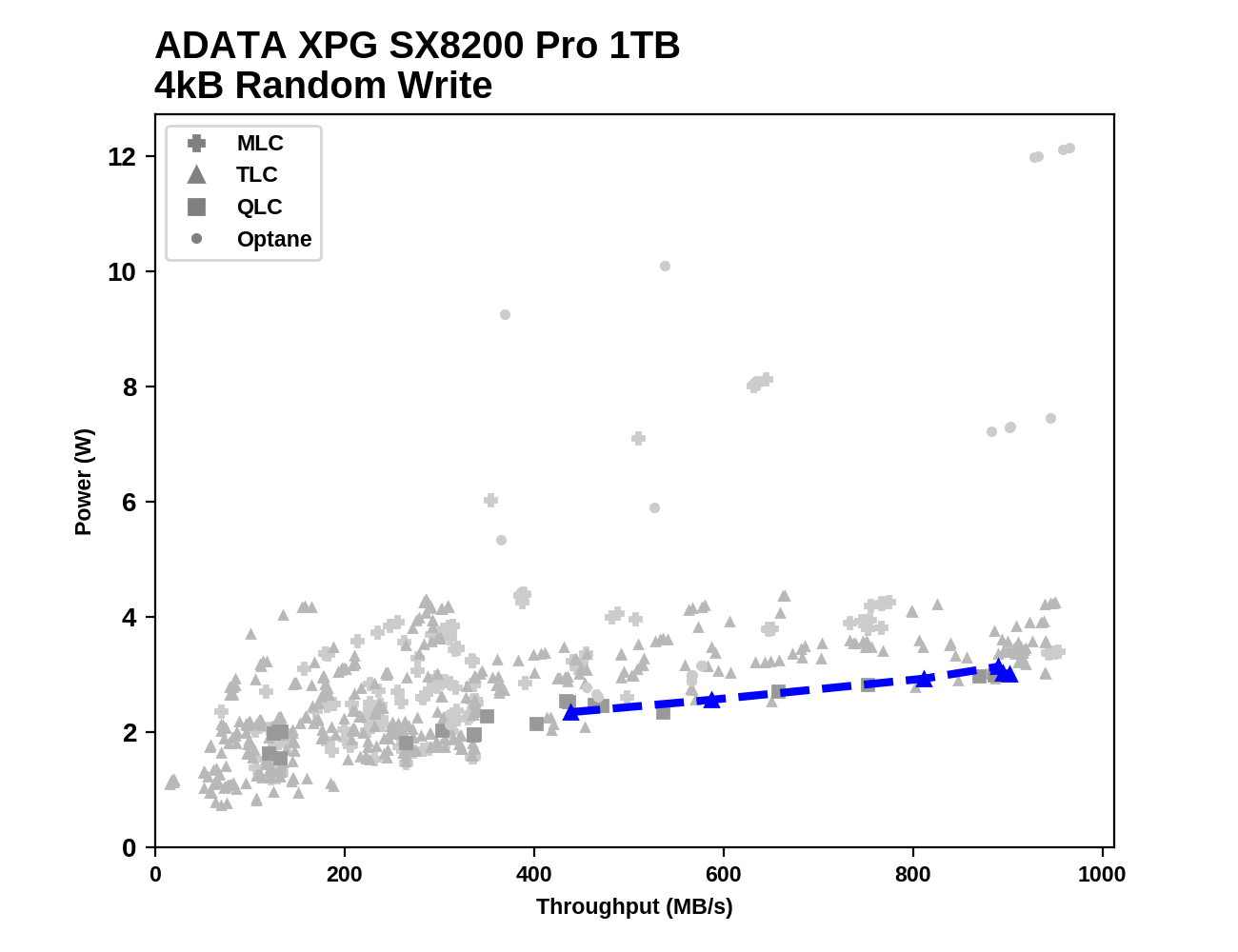








42 Comments
View All Comments
wolfesteinabhi - Wednesday, February 6, 2019 - link
this is a bit of worrying trend where we are getting same products with new/updated firmware...the firmware that was essentially free earlier...and get improved performance...now they have to pay and buy new hardware for it.ERJ - Wednesday, February 6, 2019 - link
When is the last time you updated the firmware on your hard drive? RAID card / BIOS / Video Card sure, but hard drive?Now, you could argue that the controller is essentially part of the hard drive in this case but still.
jeremyshaw - Wednesday, February 6, 2019 - link
Hard drive? They aren't that old, right? You do remember HDD firmware updates. As for SSDs, I've recently updated the firmware on my SSDs. Heck, even my monitor has been through a firmware update. Like the SSD updates, the monitor firmware affected performance and compatibility.jabber - Thursday, February 7, 2019 - link
I used to worry about SSD firmware updates when I was getting in 1 every blue moon and it had novelty value but 200+ SSDs later I now just don't bother. At the end of the day getting an extra 30MBps just isnt the boost it was all those years ago.ridic987 - Wednesday, February 6, 2019 - link
We are discussing SSD's not hard drive. Literally the thing what he is saying most applies to.Samus - Thursday, February 7, 2019 - link
I agree, the lack of SSD firmware updates - particularly what WD has pulled with the Black SSD's - is troubling. To artificially limit product improvement through restricting software updates and requiring the user to purchase an entirely new product sets a bad precedent. They could at least do what HP does in the server market and charge for support beyond the warranty. After a server warranty is up (typically 3 years) you have to pay for firmware and BIOS updates for servers. This isn't a terrible policy, at least it wasn't until meltdown\spectre hit and all the sudden it seemed somewhat necessary to update server firmware that were many years old.Hard drives get firmware updates all the time - just not from the manufacturers. They typically applicable to retail products for reasons. But go ahead and look up a random OEM PC's drivers from Dell or HP and you might see various firmware updates available for the hard disk models those PC's shipped with.
Are they important though? Rarely. Barring any significant bug, hard disks have little to benefit from firmware updates as they are so mechanically limited and the controllers are generally quite mature, having been based on incremental generations of past firmware. This could all change as MAMR and HAMR become more mainstream, the same way the only hard disk firmware I remember being common were the WD Black2 (the SSD+HDD hybrid) and various Seagate SSHD's - for obvious reasons. The technology was new, and there are benefits to updating the SSD firmware as improvements are made through testing and customer feedback.
melgross - Thursday, February 7, 2019 - link
I think of it the other way around. Unless there’s a serious bug in the firmware, firmware upgrades are a gift, that manufacturers don’t have to give.The fact is that even when they are available, almost no one applies them. That’s true even for most who know they’re available. It’s alwasys dangerous to upgrade firmware on a product so central to needs. If there’s an unfounded bug in the new upgrade, that could be worse than firmware that’s already working just fine, but isn’t quite as fast as you might wish foe.
I’ve never seen any major upgrade in performance from a drive firmware upgrade. Ever.
FullmetalTitan - Thursday, February 7, 2019 - link
Those of us around for sandforce controllers remember well the pains of updating SSD firmware to make our drives useableDigitalFreak - Wednesday, February 6, 2019 - link
Billy - how far are we away from having 4TB M.2 NVMe drives?Billy Tallis - Wednesday, February 6, 2019 - link
Most SSD vendors could produce 4TB double-sided M.2 drives using off the shelf parts. Putting 4TB on a single-sided module would require either going with a DRAMless controller, stacking DRAM and the controller on the same package, or using 1Tb+ QLC dies instead of TLC.So currently any 4TB M.2 drive would have at least some significant downside that either compromises performance, restricts compatibility, or drives the price up well beyond twice that of a 2TB M.2 drive. There's simply not enough demand for such drives, and likely won't be anytime soon.